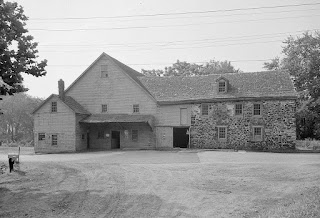 |
| Greenbank Mill and the Madison Factory |
Robert Philips died in late 1828, and in 1830 the property was finally sold to his nephew, John C. Philips. For the next twenty years or so, John C. Philips (1782-1854) operated the grist mill, as well as a saw mill that was installed sometime before 1822. (The saw mill was mentioned in an ad attempting to sell the mills that year, but since it was not uncommon to have a saw mill operating alongside a grist mill, it could have been in place much earlier). Eventually John was joined in business by several of his sons, who would initiate the next chapter in the story of Greenbank Mill. And like with the woolen venture of their great uncle, these Philips brothers would be responding to changes in the business climate around them, albeit on a somewhat more local level.
Whereas Robert Philips was reacting to events as far away as Europe, his nephew's boys took advantage of developments closer to home, in Wilmington. By the mid-1800's, for a variety of reasons, the once-small milling and trading town was developing into an industrial manufacturing city. One industry that took hold early was carriage manufacturing. (Incidentally, the types of skills and workmen needed for this later gave rise to the railcar and shipbuilding industries that came about later in the century in Wilmington.) Since all of these carriage manufacturers needed parts, John C. Philips' sons saw an opportunity. When John's sons first began to take over operation of the mill around mid-century, it appears that it was run only as a grist mill, under supervision of the oldest, Calvin Philips. About 1852 Calvin moved to Philadelphia, and ownership of the mill went to his brothers.
These brothers, Isaac D. and William G. Philips, seeing what was happening in the city, decided to expand upon the woodworking aspect of the mill. They adapted the mill to make wooden implements and objects, specifically spokes and felloes for carriage wheels. (The felloe is the curved outer part of the wheel, what we might call the rim.) They also manufactured other objects, like croquet mallets, forks (I think meaning pitchforks), folding chairs, folding stools, and step ladders. The new firm of W. G. Philips and Bro. seems to have operated fairly successfully for over twenty-five years, under the control of the Philips brothers.
 |
| William G. Philips House |
William G. Philips died in October 1876, at which time the mill and business went solely to Isaac. It was also probably at this point that Isaac brought in another partner to the firm, John P. Wells. The company's name was changed to J.P. Wells & Co., and it was run by Wells and Isaac's son, John C. Philips. The decision to bring in Wells turned out to be a very bad one. One day in 1879, Wells left town supposedly to attend a funeral in Baltimore. Wells never returned, and neither did much of the firm's cash. The company's debt was too much to bear, and the spoke and felloe factory was closed by order of the sheriff. The days of woodworking at Greenbank were over.
 |
| Greenbank Mill, outbuildings, and tenant houses. C. early 1900's |
Milling at the site, however, continued. Operating under the name of I.D. Philips and Son, flour milling continued in Robert Philips' 1790 gristmill, and the family even had a store on Fourth Street in Wilmington. In 1883 the firm was reorganized as the Diamond Milling Company, with John C. Philips still intimately involved in the operation of the mill. By this time, though, the flour milling industry had outgrown small mills like Greenbank, and had moved on to larger-scale ones in the Midwest. Mills like Greenbank couldn't hope to compete on anything but a local scale, which is exactly what it ended up doing.
In 1888, Isaac D. Philips sold the mill to James and Ellis Clark, ending the Philips family's 115 year tenure at the site. Greenbank passed through several hands over the ensuing decades, but remained in operation the entire time, doing custom milling for local farmers. By the 1960's, it was the only grist mill operating in Delaware on water power. It was operated then by Roy Magargal, who began working at the mill in the 1920's and would continue to do so for over 45 years. Even after the mill was purchased by the group Historic Red Clay Valley, Inc. (HRCV, also owners of the Wilmington & Western) and partially converted to a museum, Magargal still milled during the week while visitors came on the weekends.
 |
| Greenbank Mill, 1958 |
Unfortunately, the business days of the mill were numbered. In 1969 vandals set fire to the structure, bringing to an end nearly three centuries of milling at the site. This was far from the end of the Greenbank story, though. (It wasn't even the end for Magargal, who continued to run a feed business out of the office.) Newly-formed as a division of HRCV, the Friends of Greenbank Mill set out on the long process of restoring this important piece of MCH history. The fire had heavily damaged the gristmill, and had devastated the Madison Factory. The stone woolen mill was so damaged by the blaze that it had to be torn down completely, as the bottom picture below shows. Little by little, though, dedicated volunteers and employees worked to bring the mill back to life.
 |
| The mill in September 1969, after the fire |
 |
| Greenbank Mill, minus the Madison Factory, after 1973 |
 |
| The restored Madison Factory and Greenbank Mill |
No comments:
Post a Comment